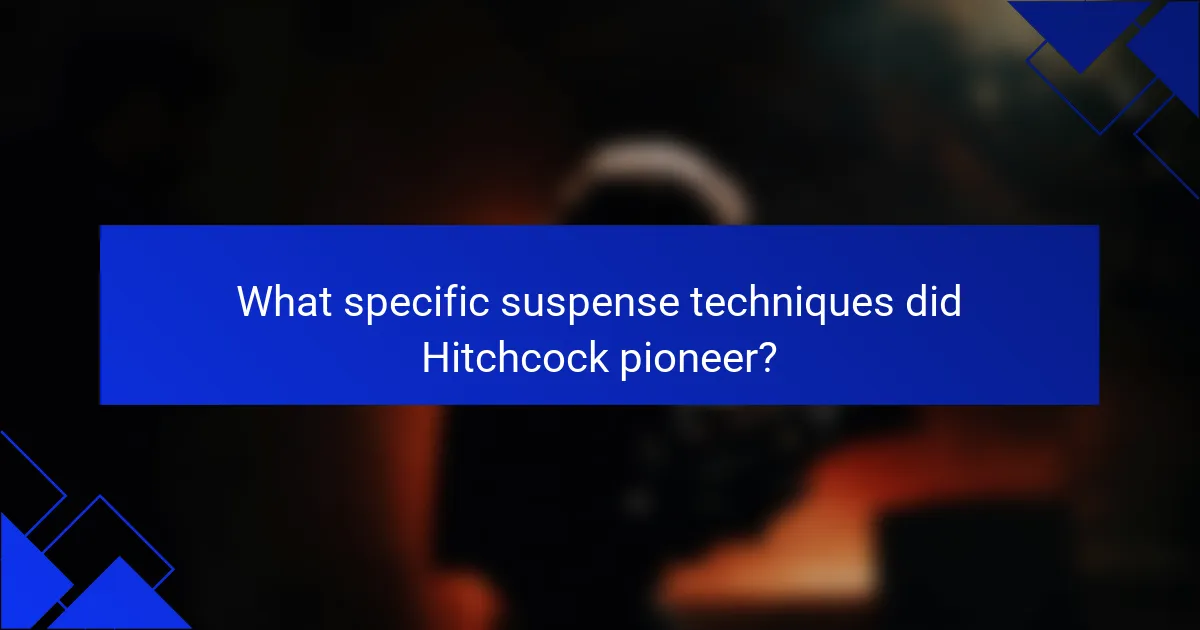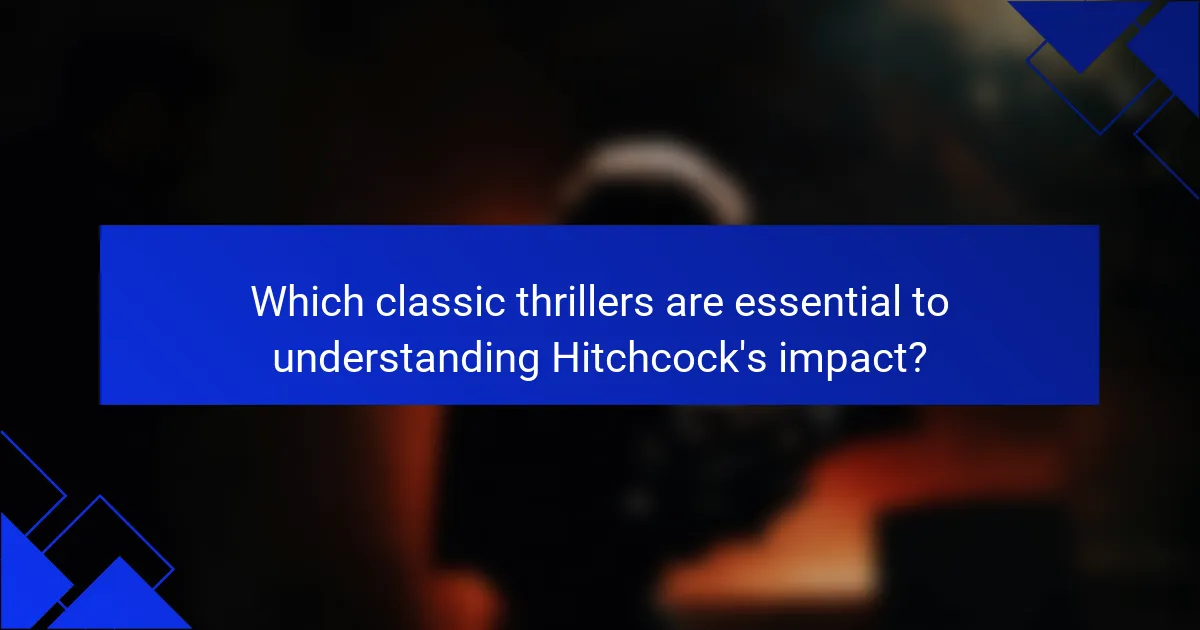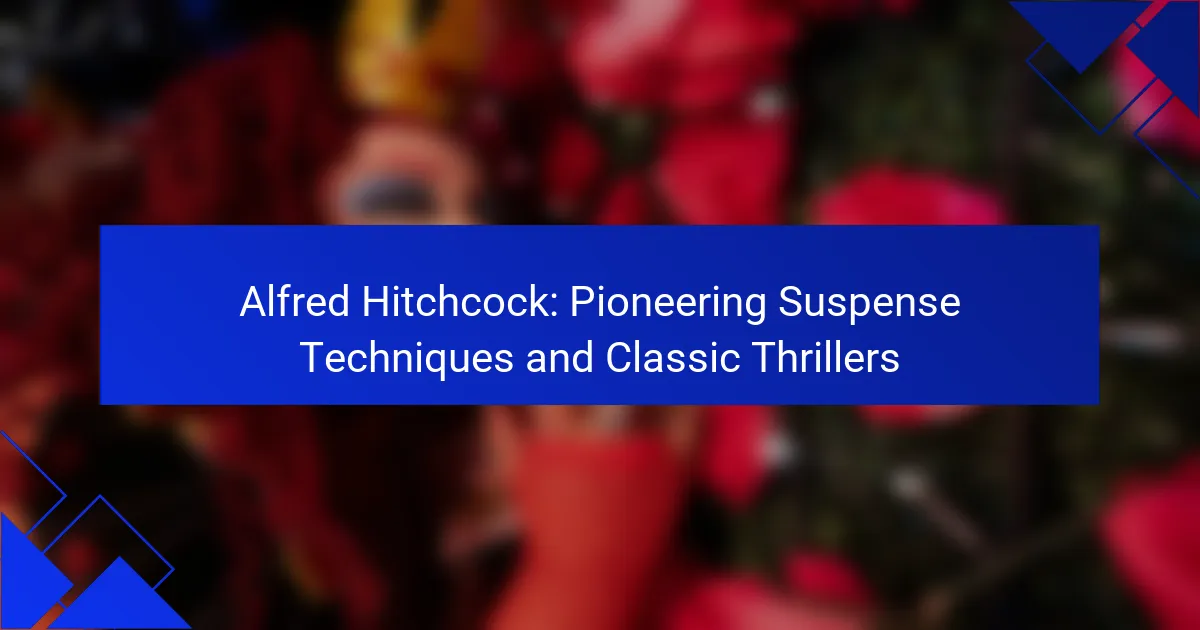
Who is Alfred Hitchcock and why is he significant in film history?
Alfred Hitchcock was a British film director and producer. He is significant in film history for pioneering suspense techniques. Hitchcock’s unique style transformed the thriller genre. He introduced innovative camera angles and editing techniques. His films often featured psychological themes and complex characters. Notable works include “Psycho,” “Rear Window,” and “Vertigo.” Hitchcock’s influence extends to contemporary filmmakers. He is often referred to as the “Master of Suspense.” His contributions to cinema have shaped narrative storytelling in film.
What are the key milestones in Alfred Hitchcock’s career?
Alfred Hitchcock’s career includes several key milestones. He directed his first film, “The Pleasure Garden,” in 1925. In 1929, he released “Blackmail,” which was the first British sound film. His Hollywood debut came in 1940 with “Rebecca,” which won the Academy Award for Best Picture. In 1954, Hitchcock released “Rear Window,” a critical and commercial success. The 1960 film “Psycho” revolutionized the horror genre and is considered one of his masterpieces. In 1963, he directed “The Birds,” which further established his reputation for suspense. Hitchcock received the AFI Life Achievement Award in 1979, recognizing his impact on cinema. He passed away in 1980, leaving a lasting legacy in filmmaking.
How did Hitchcock’s early life influence his filmmaking style?
Hitchcock’s early life significantly influenced his filmmaking style. Born in 1899 in London, he experienced a strict upbringing. His father was a wholesale poultry dealer, and his mother was a homemaker. This environment instilled in him a sense of discipline and control.
Hitchcock’s childhood was marked by a fascination with the macabre. He was exposed to dark themes from an early age, which later manifested in his films. His experiences with fear and isolation shaped his understanding of suspense.
Additionally, Hitchcock’s early interest in visual storytelling began with his education at the London County Council School of Art. He developed a keen eye for composition and framing. These skills became fundamental to his filmmaking technique.
His early career in the film industry, starting as a title card designer, allowed him to understand narrative pacing. This knowledge contributed to his mastery of suspenseful storytelling. Overall, Hitchcock’s formative years laid the groundwork for his innovative approach to cinema.
What notable films marked Hitchcock’s rise to fame?
Notable films that marked Alfred Hitchcock’s rise to fame include “The Lodger” and “Blackmail.” “The Lodger,” released in 1927, was one of his first major successes. It showcased his emerging style in suspense and psychological tension. “Blackmail,” released in 1929, was Hitchcock’s first sound film. It further established his reputation for innovative storytelling and visual techniques. These films laid the foundation for his later masterpieces, such as “Psycho” and “Rear Window.” Hitchcock’s unique approach to suspense became a defining characteristic of his work.
What are Hitchcock’s most recognized contributions to suspense in film?
Hitchcock’s most recognized contributions to suspense in film include the use of psychological tension, innovative editing techniques, and the concept of the “MacGuffin.” He masterfully built suspense by creating emotional connections between characters and the audience. Hitchcock employed techniques like the “vertigo effect” to manipulate viewers’ perceptions. His use of music and sound design heightened tension in key scenes. The famous shower scene in “Psycho” exemplifies his ability to create shock and suspense through editing. Hitchcock’s storytelling often involved placing characters in perilous situations, raising stakes for the audience. He also pioneered the use of point-of-view shots to immerse viewers in the characters’ experiences. His influence on the thriller genre is evident in countless films that followed.
How did Hitchcock define and innovate the genre of suspense?
Hitchcock defined suspense as the tension created by withholding information from the audience. He innovated the genre through techniques like the “MacGuffin,” which focuses on the characters’ motivations rather than the plot itself. His use of close-ups intensified emotional engagement with characters. Hitchcock also employed innovative camera angles to create unease and anticipation. He mastered the art of pacing, carefully timing reveals to maintain tension. His films often featured ordinary characters in extraordinary situations, heightening relatability and fear. The use of music and sound effects in his works, such as in “Psycho,” added layers of psychological tension. Hitchcock’s influence reshaped cinematic storytelling, establishing a blueprint for future suspense films.
What techniques did Hitchcock use to build tension and suspense?
Hitchcock used several techniques to build tension and suspense in his films. He employed the use of suspenseful music to enhance emotional responses. His innovative camera angles created a sense of unease and anticipation. Hitchcock also utilized the technique of “dramatic irony,” where the audience knows more than the characters. This method heightens anxiety as viewers anticipate impending danger. He often incorporated slow pacing to prolong moments of uncertainty. The use of close-ups intensified emotional engagement with characters. Additionally, Hitchcock’s strategic use of lighting created stark contrasts, amplifying tension. His masterful editing techniques, such as cross-cutting, built suspense by juxtaposing multiple storylines. These techniques collectively established Hitchcock’s reputation as a master of suspense.
What themes are prevalent in Hitchcock’s classic thrillers?
Hitchcock’s classic thrillers often explore themes of voyeurism, identity, and the psychological aspects of fear. Voyeurism is prominently featured, as seen in “Rear Window,” where the protagonist observes his neighbors. Identity is another critical theme, exemplified in “Vertigo,” where characters grapple with their true selves. The psychological manipulation of fear is evident in “Psycho,” where the unexpected twists unsettle viewers. Additionally, themes of obsession are prevalent, particularly in “Rebecca,” showcasing characters’ intense fixations. These recurring themes contribute to Hitchcock’s unique storytelling style and enduring impact on the thriller genre.
How do psychological elements play a role in Hitchcock’s storytelling?
Psychological elements are central to Hitchcock’s storytelling. He often explores themes of fear, guilt, and obsession. Characters in his films frequently experience intense psychological conflict. This creates suspense and engages the audience on a deeper emotional level. For example, in “Psycho,” Norman Bates embodies the complexities of mental illness. His split personality drives the narrative and heightens tension. Hitchcock’s use of visual techniques enhances psychological impact. Close-ups and shadows evoke feelings of unease. The sound design also contributes to the psychological atmosphere. These elements work together to create a compelling and immersive experience.
What recurring motifs can be found in his films?
Recurring motifs in Alfred Hitchcock’s films include themes of voyeurism, mistaken identity, and the macabre. Voyeurism is often depicted through characters observing others without their knowledge. Mistaken identity creates tension and drives the plot in films like “North by Northwest.” The macabre is present in many of his works, showcasing dark humor and psychological horror. Additionally, the use of suspenseful music heightens tension throughout his films. Hitchcock’s fascination with the duality of human nature is also evident, showcasing characters with hidden motives. These motifs contribute to his unique storytelling style and have influenced the thriller genre significantly.
How did Hitchcock’s work influence modern filmmaking?
Hitchcock’s work significantly influenced modern filmmaking through his innovative narrative techniques and psychological depth. He pioneered the use of suspense and tension, creating a blueprint for thriller genres. His use of editing techniques, such as the ” montage,” shaped pacing and storytelling. Hitchcock’s focus on character psychology added complexity to film narratives. He also introduced the concept of the “MacGuffin,” which drives the plot while remaining secondary to character development. His films often blurred the lines between protagonist and antagonist, challenging audience perceptions. The visual style he employed, including unique camera angles and lighting, has become a staple in contemporary cinema. Hitchcock’s legacy is evident in the works of modern directors who draw inspiration from his techniques and themes.
What techniques from Hitchcock’s films are still used today?
Hitchcock’s films employed several techniques still prevalent in modern cinema. One key technique is the use of suspense through pacing and editing. Hitchcock meticulously crafted scenes to build tension, often using close-ups and reaction shots effectively. Another technique is the MacGuffin, an object that drives the plot but holds little intrinsic value. This device continues to be a popular narrative tool. Additionally, Hitchcock’s use of psychological manipulation and character development influences contemporary thriller narratives. His innovative camera angles and framing techniques also set a standard for visual storytelling. These techniques have been analyzed in film studies, confirming their lasting impact on filmmakers today.
How has Hitchcock’s legacy shaped the thriller genre in contemporary cinema?
Hitchcock’s legacy has profoundly influenced the thriller genre in contemporary cinema. His innovative techniques, such as suspenseful pacing and psychological depth, remain foundational. Filmmakers today often emulate his use of tension-building through editing and sound design. Hitchcock’s focus on character motivations has shaped modern narratives, emphasizing psychological complexity. Iconic films like “Psycho” introduced themes of voyeurism and identity that persist in today’s thrillers. His mastery of the “MacGuffin” concept has inspired plot devices in numerous films. Directors like David Fincher and Christopher Nolan cite Hitchcock as a major influence. The enduring impact of Hitchcock’s work is evident in the structure and style of contemporary thrillers.

What specific suspense techniques did Hitchcock pioneer?
Alfred Hitchcock pioneered several specific suspense techniques that have become foundational in filmmaking. He popularized the use of “suspense vs. surprise,” which emphasizes building tension by revealing information to the audience before the characters. This method creates anticipation and engagement.
Hitchcock also mastered the “MacGuffin” technique, where an object or goal drives the plot but is not crucial to the story’s resolution. This keeps the audience focused on character motivations rather than the object itself.
He effectively employed “visual storytelling,” using camera angles and framing to convey emotions and tension without dialogue. Hitchcock’s use of “cross-cutting” between different scenes heightened suspense by juxtaposing simultaneous actions.
Additionally, he utilized “psychological manipulation,” exploring characters’ fears and obsessions to create deeper emotional stakes. His innovative use of sound, such as in “Psycho,” heightened tension through auditory cues.
These techniques are evident in films like “Rear Window” and “Vertigo,” showcasing Hitchcock’s mastery in crafting suspenseful narratives.
How did Hitchcock utilize camera angles and shots to enhance suspense?
Hitchcock utilized camera angles and shots to enhance suspense through strategic framing and movement. He often employed low-angle shots to make characters appear imposing and threatening. This technique creates a sense of dread in viewers. Hitchcock also used close-ups to capture characters’ emotions, intensifying the audience’s connection to their fear. Additionally, he implemented the use of long takes to build tension gradually. The famous “Vertigo effect” showcased how zooming in while dolly moving out creates a disorienting feeling. These techniques combined to manipulate viewer perception and heighten anxiety. Hitchcock’s mastery of these elements is evident in films like “Psycho” and “Rear Window.”
What role does lighting play in creating suspense in his films?
Lighting plays a crucial role in creating suspense in Alfred Hitchcock’s films. It helps establish mood and tension. Hitchcock often used low-key lighting to create shadows and conceal characters. This technique generates uncertainty about what might happen next. Bright lighting can also be used to highlight moments of danger. The contrast between light and dark enhances emotional impact. For instance, in “Psycho,” the use of stark lighting in the shower scene amplifies the horror. Hitchcock’s strategic use of lighting keeps audiences on edge throughout his narratives.
How did editing techniques contribute to the pacing of suspense?
Editing techniques significantly enhance the pacing of suspense in film. Techniques such as rapid cuts create a sense of urgency. Slow-motion sequences heighten tension by elongating critical moments. Cross-cutting between parallel actions builds anticipation. Montage sequences can compress time, intensifying the viewer’s emotional response. Hitchcock often employed these methods to manipulate audience expectations. For example, in “Psycho,” the quick cuts during the shower scene amplify shock. Overall, effective editing shapes the rhythm of suspenseful storytelling.
What innovative narrative structures did Hitchcock employ?
Hitchcock employed innovative narrative structures such as non-linear storytelling and subjective camera techniques. Non-linear storytelling allows for the manipulation of time and perspective. For example, “Psycho” begins with a shocking murder, then shifts focus to the investigation. Subjective camera techniques place the audience in the character’s perspective. In “Rear Window,” the protagonist’s viewpoint drives the tension. Hitchcock also utilized MacGuffins to propel the plot, creating suspense through misdirection. His use of suspenseful pacing and visual storytelling further enhances audience engagement. These techniques have influenced countless filmmakers and shaped the thriller genre.
How did non-linear storytelling affect audience engagement?
Non-linear storytelling significantly enhanced audience engagement by allowing viewers to piece together the narrative themselves. This approach creates a sense of active participation, as audiences must engage cognitively to understand the plot. It fosters curiosity and suspense, compelling viewers to seek answers to unresolved questions. Research shows that non-linear narratives can increase emotional investment, as audiences relate more deeply to character arcs that unfold unpredictably. For instance, films like “Psycho” and “Vertigo” utilized this technique effectively, drawing viewers into complex emotional landscapes. The unpredictability of the story structure keeps audiences on edge, enhancing their overall experience.
What is the significance of plot twists in Hitchcock’s films?
Plot twists in Hitchcock’s films are significant because they enhance suspense and surprise. Hitchcock masterfully uses plot twists to subvert audience expectations. This technique keeps viewers engaged and on the edge of their seats. For example, in “Psycho,” the shocking twist regarding Marion Crane’s fate alters the narrative dramatically. Such twists also reveal deeper themes, such as identity and deception. Hitchcock’s ability to mislead the audience builds tension throughout his films. This has made him a master of psychological thrillers. His plot twists have influenced countless filmmakers and are a hallmark of his storytelling style.

Which classic thrillers are essential to understanding Hitchcock’s impact?
Psycho, Rear Window, and Vertigo are classic thrillers essential to understanding Hitchcock’s impact. Psycho, released in 1960, revolutionized the horror genre with its shocking narrative twists. Rear Window, from 1954, showcased Hitchcock’s mastery of suspense through voyeurism and psychological tension. Vertigo, released in 1958, is renowned for its complex themes of obsession and identity. These films highlight Hitchcock’s innovative techniques, such as the use of music and camera angles to enhance suspense. Collectively, they demonstrate his influence on filmmaking and the thriller genre.
What are the defining characteristics of “Psycho” as a thriller?
“Psycho” is defined by its psychological tension, unexpected plot twists, and character complexity. The film employs a non-linear narrative structure that keeps viewers on edge. It features a chilling score that enhances the suspenseful atmosphere. The iconic shower scene exemplifies shocking violence that challenges audience expectations. Alfred Hitchcock’s masterful direction creates an unsettling mood throughout. The character of Norman Bates embodies duality, blurring lines between victim and villain. “Psycho” subverts traditional horror tropes, making it a groundbreaking thriller. Its influence on the genre is evident in countless subsequent films.
How did “Psycho” redefine the horror and thriller genres?
“Psycho” redefined the horror and thriller genres by introducing psychological depth and shocking plot twists. The film’s infamous shower scene showcased graphic violence that was unprecedented for its time. It also blurred the lines between protagonist and antagonist, creating complex character dynamics. Alfred Hitchcock’s use of suspense techniques kept audiences on edge throughout the film. The narrative structure, which killed off the apparent lead character early, challenged conventional storytelling. “Psycho” also emphasized the theme of duality, exploring the darker aspects of human nature. Its impact is evident in countless films that followed, influencing the development of slasher and psychological horror subgenres. The film’s innovative approach to music and sound design further heightened its tension and fear.
What innovative techniques were introduced in “Psycho”?
“Psycho” introduced several innovative techniques in filmmaking. One significant technique was the use of a non-linear narrative. This approach kept audiences engaged and surprised. Another innovation was the use of music to enhance suspense. Bernard Herrmann’s score became iconic and set a new standard for thrillers. The film also employed innovative camera angles and editing techniques. The famous shower scene utilized rapid cuts to create tension. Hitchcock’s use of psychological horror was groundbreaking at the time. These techniques contributed to “Psycho” being a landmark film in cinematic history.
What makes “Rear Window” a quintessential Hitchcock film?
“Rear Window” is a quintessential Hitchcock film due to its masterful use of suspense and voyeurism. The film centers on a wheelchair-bound photographer who believes he has witnessed a murder. This premise creates an intense atmosphere of tension and uncertainty. Hitchcock expertly builds suspense through limited perspectives and confined settings. The audience experiences the protagonist’s paranoia and fear, enhancing the psychological tension. The film also explores themes of morality and human curiosity. These elements are characteristic of Hitchcock’s style, showcasing his innovative storytelling techniques. “Rear Window” remains a defining work in the thriller genre, exemplifying Hitchcock’s influence on cinematic suspense.
How does “Rear Window” explore themes of voyeurism and suspense?
“Rear Window” explores themes of voyeurism and suspense through its protagonist, L.B. Jeffries, who observes his neighbors from his apartment. This act of watching creates a sense of voyeurism as Jeffries becomes engrossed in their lives. The film builds suspense by presenting the possibility of a murder occurring next door. Jeffries’ increasing obsession leads him to investigate further, heightening the tension. The use of limited perspective confines the audience to Jeffries’ viewpoint. This restriction amplifies the suspense as viewers share his uncertainty and fear. The film’s climax reveals the consequences of voyeurism, as Jeffries confronts the murderer. Hitchcock masterfully intertwines these themes, making “Rear Window” a study in psychological tension and moral ambiguity.
What cinematographic techniques are notable in “Rear Window”?
Notable cinematographic techniques in “Rear Window” include the use of voyeuristic framing and limited perspective. The film employs long takes to build tension and immerse the audience in the protagonist’s point of view. Close-ups are frequently used to convey emotion and detail. The film’s set design creates a confined space that enhances suspense. Lighting plays a critical role in establishing mood and highlighting key actions. The use of sound is minimal, focusing on diegetic noises to amplify tension. These techniques collectively contribute to the film’s suspenseful atmosphere and narrative depth.
What lessons can filmmakers learn from Hitchcock’s approach to suspense?
Filmmakers can learn to build suspense through careful pacing and audience engagement. Hitchcock often manipulated time to create tension, allowing moments to linger. He also used the technique of dramatic irony, where the audience knows more than the characters. This creates a sense of anticipation and dread. Hitchcock’s use of visual storytelling, such as framing and camera angles, enhances emotional impact. He expertly crafted soundscapes to amplify tension. By controlling what is shown and withheld, filmmakers can evoke fear and curiosity. Hitchcock’s mastery of these techniques has influenced countless filmmakers in crafting suspenseful narratives.
How can Hitchcock’s techniques be applied to modern storytelling?
Hitchcock’s techniques can enhance modern storytelling through suspense and character development. His mastery of tension keeps audiences engaged. Filmmakers can use his signature “MacGuffin” to drive plots forward. This device creates intrigue by making an object or goal central to the story. Additionally, Hitchcock’s use of visual storytelling emphasizes emotions without dialogue. This technique allows for deeper audience connection. His innovative editing techniques, such as cross-cutting, maintain pacing and build suspense. Modern creators can also adopt his focus on psychological depth in characters. This approach fosters empathy and complexity, enriching narratives. These principles have influenced numerous contemporary filmmakers, proving their relevance today.
What best practices can emerging filmmakers adopt from Hitchcock’s work?
Emerging filmmakers can adopt several best practices from Alfred Hitchcock’s work. First, they should focus on building suspense through pacing and timing. Hitchcock expertly manipulated time to create tension in scenes. Second, they should utilize visual storytelling effectively. Hitchcock believed in showing rather than telling, often using imagery to convey emotions. Third, filmmakers should craft compelling characters. Hitchcock’s characters were complex, driving the narrative forward. Fourth, they should master the art of misdirection. Hitchcock often led audiences to false conclusions, enhancing the surprise element. Fifth, sound design is crucial. Hitchcock used sound to amplify emotions and heighten suspense. These practices contribute to creating engaging and memorable films, as evidenced by Hitchcock’s enduring legacy in cinema.
Alfred Hitchcock, a British film director and producer, is renowned for pioneering suspense techniques that transformed the thriller genre. This article explores Hitchcock’s significant contributions to film history, including his innovative camera angles, editing techniques, and psychological themes found in notable works such as “Psycho,” “Rear Window,” and “Vertigo.” Key milestones in his career, his early life influences, and the recurring motifs in his films are examined, along with the lasting impact of his techniques on modern filmmaking. Additionally, the article highlights essential films that define Hitchcock’s legacy and the lessons filmmakers can learn from his mastery of suspense.
